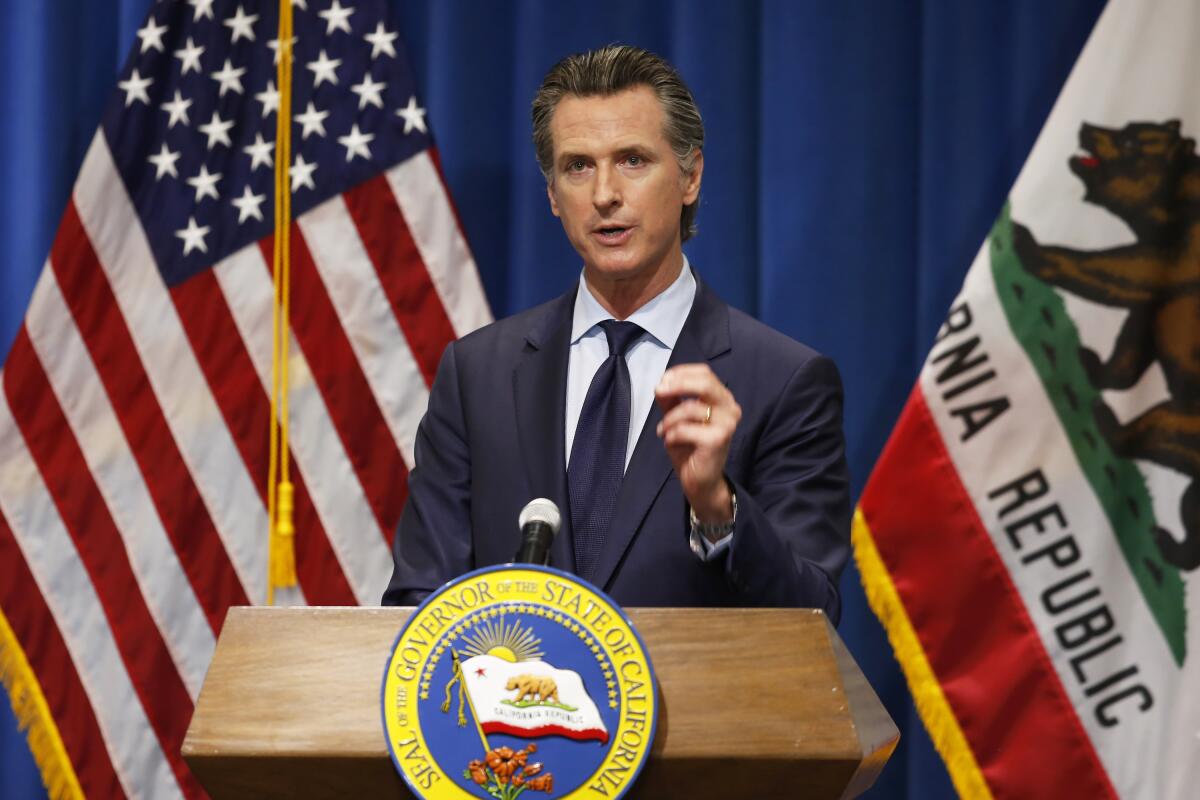Editorial: Newsom is right: Let’s get more money in poor Californians’ pockets now

- Share via
Here’s some welcome news for California’s working poor: Gov. Gavin Newsom has proposed giving millions of low-income taxpayers a $600 Golden State Stimulus payment. The checks would be paid out of the state’s unexpected multibillion-dollar surplus.
The $2.4-billion proposal would be California’s version of the federal government’s $600 Economic Impact Payments that are now beginning to arrive. The Legislature should quickly approve the relief checks, which were included in the budget Newsom proposed Friday, so that state money can be delivered as soon as next month.
While the federal checks are expected to reach about 85% of American households, Newsom is suggesting a better course for the state: He wants to give the money just to low-income households, which number about 4 million. These are often the working people who have borne the brunt of the pandemic and its economic fallout, and many of them desperately need help.
And what better way to use the state’s latest surplus than give direct payments to lift up the most vulnerable? Even though the California economy has suffered in the pandemic, Newsom’s budget projects a windfall because the state’s tax structure relies heavily on high-income residents who have continued to do well this year. Policymakers often rue the state’s dependence on the volatile capital gains taxes paid by upper-income Californians, but that revenue is expected to grow again this fiscal year, amounting to more than $18 billion, or 11% of the state’s general fund.
Certainly the state’s longer-term financial picture is worrisome. Analysts predict a budget deficit next year as a result of the broader economic losses. But right now, with this budget, California lawmakers’ most important job is to help the people who are having trouble staying afloat. And in so doing, they may help narrow the yawning income inequality gap that the pandemic has only exacerbated.
Life was already hard in California for the working poor before COVID-19 hit. The state has the nation’s highest poverty rate when the high cost of living here is factored in. A lot of low-income families have only recently rebounded financially from the last recession. Many spend almost half their income on rent and have little money left to sock away for an emergency expense, much less a lengthy illness or hospitalization.
COVID-19 only made the situation worse. Low-income workers have been the hardest hit by job losses. Many are employed in hospitality, entertainment, retail and other service industries that have shuttered or reduced operations in response to pandemic-related restrictions.
The federal government’s $1,200 stimulus payments early last year helped keep a lot of people afloat for a while. So did extra unemployment benefits — initially $600 a week, then $300. Eviction moratoriums allowed tenants to stay housed if they fell behind on their rent, though their rent debt continues to grow. But the financial crunch is apparent in the long lines at food banks and the growing number of people who are paying their rent with credit cards.
Struggling families can hold on only for so long; eventually all that debt is going to come due and, without help, this year-long pandemic could translate into financial burdens that drag them down for long into the future.
No, a one-time $600 payment won’t end the economic struggle for recipients. But the Golden State Stimulus is an important relief effort, especially when paired with the federal stimulus and much-needed federal aid for low-income tenants and their landlords.
The governor’s proposal calls for distributing the $600 to taxpayers who received the state’s Earned Income Tax Credit in 2020. These are residents who have annual incomes of $30,000 or less. About 3.9 million households applied for the tax credit last year. The money will also go to eligible tax-paying noncitizens, who were excluded from the federal checks.
The state stimulus is a big piece, but it’s not the only feature of Newsom’s proposed pandemic response. His budget dedicates about $14 billion to relief and infection control efforts, including money to help accelerate vaccinations, $575 million in grants for small businesses, and dollars to help schools reopen their classrooms sooner.
COVID-19 has been brutal for California communities, but the end is in sight. Newsom’s proposed stimulus payments can help the state’s struggling residents make it to the other side.
More to Read
A cure for the common opinion
Get thought-provoking perspectives with our weekly newsletter.
You may occasionally receive promotional content from the Los Angeles Times.










